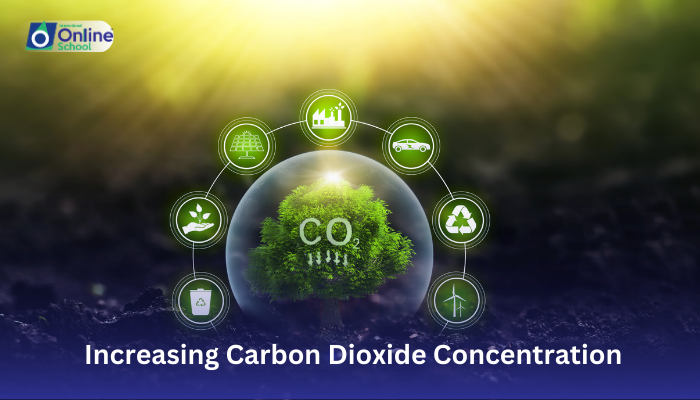
Learning Outcomes:
i. Explain the concept of carbon dioxide (CO₂) and its role as a greenhouse gas in the atmosphere.
ii. Identify and analyze the key human activities contributing to the increase in CO₂ concentration.
iii. Appreciate the connection between rising CO₂ levels and the threat of climate change.
Introduction:
Imagine a blanket of air, invisible yet vital, surrounding our planet. This blanket, the atmosphere, plays a crucial role in regulating Earth's temperature, making it habitable for life. However, this vital blanket is changing, becoming thicker with an unwelcome guest: carbon dioxide (CO₂). Today, we embark on a journey to understand the culprits behind this rise in CO₂, uncovering the human activities that are tipping the scales of our planet's climate.
i. The Villain in the Air: Understanding CO₂:
CO₂ is a natural gas present in the atmosphere, but its concentration has been steadily rising due to human activities. This rise is concerning because CO₂ acts like a greenhouse gas, trapping heat from the sun, causing the Earth's temperature to rise – a phenomenon known as global warming.
ii. The Fingerprints of Human Activity:
Several human activities are contributing to the rise in CO₂:
Burning fossil fuels: Coal, oil, and natural gas are major sources of energy, but burning them releases large amounts of CO₂ into the atmosphere. From power plants to vehicles, fossil fuel dependence fuels the CO₂ surge.
Deforestation: Forests act as natural carbon sinks, absorbing CO₂ from the air. However, deforestation for agriculture, logging, and development destroys these vital carbon absorbers, further tipping the CO₂ balance.
Industrial processes: Cement production, manufacturing, and other industrial activities release CO₂ as a byproduct, adding to the atmospheric burden.
Agriculture: Livestock farming and agricultural practices like intensive farming and fertilizer use contribute to CO₂ emissions, both directly and indirectly.
iii. The Looming Shadow of Climate Change:
The rise in CO₂ is not just a number; it's a warning bell. Increasing temperatures lead to a cascade of effects:
Melting glaciers and rising sea levels: Threatening coastal communities and ecosystems.
Extreme weather events: More frequent and intense heatwaves, droughts, floods, and storms.
Changes in ecosystems: Disrupting plant and animal life, leading to biodiversity loss.
Impact on human health: Heat-related illnesses, respiratory problems, and food insecurity.
The rising CO₂ concentration is a stark reminder that our actions have consequences. By understanding the human activities responsible for this increase and appreciating the link to climate change, we can begin to chart a course towards a more sustainable future. Remember, every action, from our energy choices to our consumption habits, leaves a footprint on the invisible blanket of the atmosphere. It's our responsibility to choose actions that lighten that footprint, ensuring a future where the Earth's climate remains hospitable for generations to come.